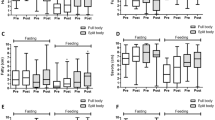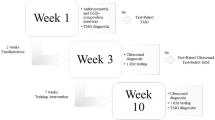Abstract
Background:
Resistance training (RT) has selective effects on body composition that may counteract the deleterious effects of aging. Changes in phase angle (PhA) may serve to monitor the influence of RT in older people.
Objectives:
To describe the effect of RT in training, detraining and retraining on body composition, including PhA in older women.
Subjects/methods:
Thirty-three older women (⩾60 years old) participated. The RT program was carried out over 12 weeks for each stage (training, detraining and retraining). Whole-body fat-free mass and fat mass (FM) and appendicular lean soft tissue (ALST) measurements were carried out using a dual energy X-ray absorptiometry. Bioimpedance spectroscopy was used to estimate total body water (TBW), intra (ICF) and extracellular (ECF) fluids, whole-body resistance (R) and reactance (Xc) and PhA. Upper and lower body muscle strength were also assessed.
Results:
From baseline to after training muscle strength, ALST and PhA significantly (P<0.05) increased. In detraining, significant (P<0.05) reductions in muscle strength, TBW, ECF, ICF and PhA along with significant (P<0.05) increases in R were observed, with the greatest magnitude observed for PhA (Δ=−7.6%). From detraining to retraining a significant reduction in FM along with increases in Xc, PhA and muscle strength were observed. Although an increase was observed from detraining to retraining in PhA, the values were still lower than baseline PhA.
Conclusions:
In untrained older women, a RT is associated with increases in PhA, whereas detraining results in a marked decrease in PhA, and more time may be required in retraining to counteract the negative influence of absence of exercise stimulus.
This is a preview of subscription content, access via your institution
Access options
Subscribe to this journal
Receive 12 print issues and online access
$259.00 per year
only $21.58 per issue
Buy this article
- Purchase on Springer Link
- Instant access to full article PDF
Prices may be subject to local taxes which are calculated during checkout




Similar content being viewed by others
References
Hurley BF, Hanson ED, Sheaff AK . Strength training as a countermeasure to aging muscle and chronic disease. Sports Med 2011; 41: 289–306.
Phillips SM . Resistance exercise: good for more than just Grandma and Grandpa's muscles. Appl Physiol Nutr Metab 2007; 32: 1198–1205.
Peterson MD, Gordon PM . Resistance exercise for the aging adult: clinical implications and prescription guidelines. Am J Med 2011; 124: 194–198.
Peterson MD, Rhea MR, Sen A, Gordon PM . Resistance exercise for muscular strength in older adults: a meta-analysis. Ageing Res Rev 2010; 9: 226–237.
Peterson MD, Sen A, Gordon PM . Influence of resistance exercise on lean body mass in aging adults: a meta-analysis. Med Sci Sports Exerc 2011; 43: 249–258.
Kyle UG, Bosaeus I, De Lorenzo AD, Deurenberg P, Elia M, Gomez JM et al. Bioelectrical impedance analysis—part I: review of principles and methods. Clin Nutr 2004; 23: 1226–1243.
Kyle UG, Bosaeus I, De Lorenzo AD, Deurenberg P, Elia M, Manuel Gomez J et al. Bioelectrical impedance analysis-part II: utilization in clinical practice. Clin Nutr 2004; 23: 1430–1453.
Lukaski HC . Evolution of bioimpedance: a circuitous journey from estimation of physiological function to assessment of body composition and a return to clinical research. Eur J Clin Nutr 2013; 67 (Suppl 1), S2–S9.
Basile C, Della-Morte D, Cacciatore F, Gargiulo G, Galizia G, Roselli M et al. Phase angle as bioelectrical marker to identify elderly patients at risk of sarcopenia. Exp Gerontol 2014; 58: 43–46.
Marini E, Buffa R, Saragat B, Coin A, Toffanello ED, Berton L et al. The potential of classic and specific bioelectrical impedance vector analysis for the assessment of sarcopenia and sarcopenic obesity. Clin Interv Aging 2012; 7: 585–591.
Taaffe DR, Henwood TR, Nalls MA, Walker DG, Lang TF, Harris TB . Alterations in muscle attenuation following detraining and retraining in resistance-trained older adults. Gerontology 2009; 55: 217–223.
Norman K, Wirth R, Neubauer M, Eckardt R, Stobaus N . The bioimpedance phase angle predicts low muscle strength, impaired quality of life, and increased mortality in old patients with cancer. J Am Med Dir Assoc 2015; 16: 173.e117–22.
Ruiz M . Capsule commentary on Wilhelm-Leen et al., phase angle, frailty and mortality in older adults. J Gen Intern Med 2014; 29: 183.
Wilhelm-Leen ER, Hall YN, Horwitz RI, Chertow GM . Phase angle, frailty and mortality in older adults. J Gen Intern Med 2014; 29: 147–154.
Beberashvili I, Azar A, Sinuani I, Kadoshi H, Shapiro G, Feldman L et al. Longitudinal changes in bioimpedance phase angle reflect inverse changes in serum IL-6 levels in maintenance hemodialysis patients. Nutrition 2014; 30: 297–304.
Beberashvili I, Azar A, Sinuani I, Shapiro G, Feldman L, Stav K et al. Bioimpedance phase angle predicts muscle function, quality of life and clinical outcome in maintenance hemodialysis patients. Eur J Clin Nutr 2014; 68: 683–689.
Walker DG, Obesity: preventing and managing the global epidemic. Report of a WHO consultation. In: World Health Organization technical report series, Geneva. 2001/03/10 ed, 2000, pp i-xii, 1-253.
Piccoli A, Nigrelli S, Caberlotto A, Bottazzo S, Rossi B, Pillon L et al. Bivariate normal values of the bioelectrical impedance vector in adult and elderly populations. Am J Clin Nutr 1995; 61: 269–270.
Amarante do Nascimento M, Januario RS, Gerage AM, Mayhew JL, Cheche Pina FL, Cyrino ES . Familiarization and reliability of one repetition maximum strength testing in older women. J Strength Cond Res 2013; 27: 1636–1642.
American College of Sports Medicine. American College of Sports Medicine position stand. Progression models in resistance training for healthy adults. Med Sci Sports Exerc 2009; 41: 687–708.
Garber CE, Blissmer B, Deschenes MR, Franklin BA, Lamonte MJ, Lee IM et al. American College of Sports Medicine position stand. Quantity and quality of exercise for developing and maintaining cardiorespiratory, musculoskeletal, and neuromotor fitness in apparently healthy adults: guidance for prescribing exercise. Med Sci Sports Exerc 2011; 43: 1334–1359.
Bosy-Westphal A, Danielzik S, Dorhofer RP, Later W, Wiese S, Muller MJ . Phase angle from bioelectrical impedance analysis: population reference values by age, sex, and body mass index. JPEN. J Parenter Enteral Nutr 2006; 30: 309–316.
Norman K, Stobaus N, Pirlich M, Bosy-Westphal A . Bioelectrical phase angle and impedance vector analysis—clinical relevance and applicability of impedance parameters. Clin Nutr 2012; 31: 854–861.
Torres AG, Oliveira KJF, Oliveira-Junior AV, Gonçalves MC, Koury JC . Biological determinants of phase angle among Brazilian elite athletes. Proceedings of the Nutrition Society 30 June–3 July 2008; 67, (OCE8) Nottingham, UK: E332 doi:10.1017/S0029665108000062.
Rondanelli M, Klersy C, Terracol G, Talluri J, Maugeri R, Guido D et al. Whey protein, amino acids, and vitamin D supplementation with physical activity increases fat-free mass and strength, functionality, and quality of life and decreases inflammation in sarcopenic elderly. Am J Clin Nutr 2016; 103: 830–840.
Acknowledgements
We wish to express our gratitude to all the participants for their cooperation in this study. LS and MA, conducted this work during a visiting scholar period to the Faculty of Human Kinetics, University of Lisbon, Portugal, supported by the Capes Foundation within the Ministry of Education, Brazil (Process: 88887.065407/2014-00 and process: 88887.090477/2014-00, respectively). DAS is supported by a scholarship from the Portuguese Foundation for Science and Technology (SFRH/BPD/92462/2013).
Author contributions
LBS: study concept and design. DS: acquisition of subjects and data analysis. All authors: data analysis, interpretation and preparation of the paper. Sponsor’s Role: No study sponsors had any role in the study design, conduct of the study, data collection, data interpretation or preparation of the manuscript.
Author information
Authors and Affiliations
Corresponding author
Ethics declarations
Competing interests
The authors declare no conflict of interest.
Rights and permissions
About this article
Cite this article
dos Santos, L., Cyrino, E., Antunes, M. et al. Changes in phase angle and body composition induced by resistance training in older women. Eur J Clin Nutr 70, 1408–1413 (2016). https://doi.org/10.1038/ejcn.2016.124
Received:
Revised:
Accepted:
Published:
Issue Date:
DOI: https://doi.org/10.1038/ejcn.2016.124
This article is cited by
-
Physiological adaptations of active postmenopausal women and matched men to the multi-day Sardinia Selvaggio Blu wild trek: a gender-comparative pilot study
European Journal of Applied Physiology (2024)
-
Effect of resistance training on bioelectrical phase angle in older adults: a systematic review with Meta-analysis of randomized controlled trials
Reviews in Endocrine and Metabolic Disorders (2023)
-
Change in phase angle is associated with improvement in activities of daily living and muscle function in patients with acute stroke
European Geriatric Medicine (2023)
-
Not only muscle mass but also muscle quality is associated with knee extension muscle strength in patients with hip fractures
Archives of Osteoporosis (2023)
-
Phase angle (PhA) in overweight and obesity: evidence of applicability from diagnosis to weight changes in obesity treatment
Reviews in Endocrine and Metabolic Disorders (2023)



